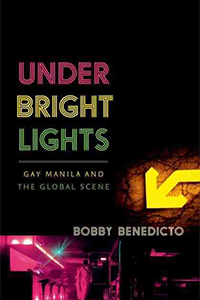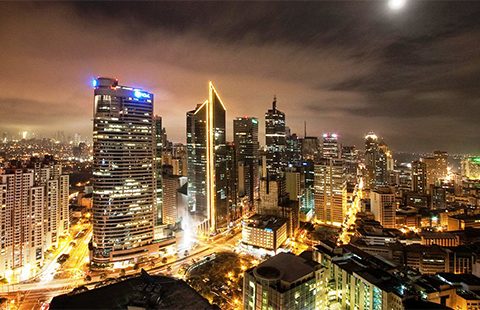
Bobby Benedicto, Under Bright Lights: Gay Manila and the Global Scene, (Minneapolis and London: University of Minnesota Press, 2014)
Reviewed by Brian Curtin
Bobby Benedicto’s Under Bright Lights is about finding complexity in typical occurrences among urban gay men of a privileged class.
Such occurrences include stumbling out of a glamorous nightclub at the end of a heady evening; speeding through a city in private transport; and viewing a metropolis from the confines of a sky-scraping apartment or hotel room.
Therein lies the book’s powerful contrast: between the securities of spaces defined by an intersection of sexual identity, and class and world contexts that can be anything but assuring of that intersection.
For Benedicto, the disorder and squalor of Manila heightens the contrast and Under Bright Lights is an intensely visual account of the ambitions, fantasies and social realities that attend the ‘bright lights’ scene. This is not, as such, a ‘gay scene’ but the spaces of a city that between them map, in Benedicto’s view, the pretensions of a gay elite that a city like Manila is indeed ‘world class’, just like LA, New York, or Berlin.
Including circuit parties (weekend long dance parties fueled by sex and drugs), and upmarket shopping malls, the fanciful nature of these spaces and the privileged mobility to move quickly between them is the backbone of an ethnographic study of a gay male milieu that also draws much on the urban theories of Paul Virilio and others that include Michel de Certeau.
Benedicto’s willingness to approach unpalatable aspects of identities and communities more usually framed as oppressed is remarkable, all the more so in view of the increase in publications on LGBTQ-related topics in Asia (for example see the Queer Asia series published by Hong Kong University Press). He rightly uses the term ‘third world’ unapologetically, writing that his book aims to “retain the material and visceral experience of poverty and global marginality it evokes and that is largely lost in euphemisms such as developing, underdeveloped and global South” (152).
In Manila, the “wanderlust that sits at the heart of a thousand gay stories is borne of ‘those states that force us to come face-to-face with the beggars who knock on our tinted windows; the underpaid traffic enforcers who swagger to our cars, palms itching for bribes” (30).
An account of the memories of an aging gay Manileño named Tony from the Marcos dictatorship, which fell in 1986, is wryly entertaining.
Tony recalls how Philippine society mixed with European royalty and Hollywood celebrities in decadent contexts where ‘ugliness’ was banned by the First Lady Imelda. He speaks of “grandeur, order and beauty” amid the lavish parties, clubs and events that claimed a modernity and ‘world class’ status as already arrived for Manila; concurrent with, of course, of the terrors inflicted by the Marcoses (xvi-xvii).
Under Bright Lights contends that local expectations of progress, change, and ‘world’ recognition should have been exhausted and politically repellent by the time that ‘gay culture’ began to cohere in its contemporary form in the Philippines (4, xiv).
Beyond the violent reign of the Marcoses, and due to seismic changes in the world at large, the growth of the gay scene couldn’t be about progress and politics but rather reflected the images and imitations of globalising and profit-hungry media-constructed identities.
While Benedicto is careful not to reinforce the notion that ‘hegemonic forces’ might successfully dupe anyone, he intelligently pulls terms such as hybridity, locality and difference away from their often celebratory use in post-colonial studies; instead remarking on the painful fragments that urban dreams of an ideal modernity can leave in their wake, and the role of identities, no matter how critically localised, in the production of social iniquity (18-19).
Under Bright Lights unfolds as a set of dense engagements with the spaces, places and figures that might inure Benedicto’s informants, associates and friends to the desires and fantasies of the so-called global scene: the spotlessness of a shopping district known as The Fort rather than gritty Cubao in Metro Manila; VIP treatment while slumming it in a male strip club; and the disavowals that occur when brushing up against Filipino workers in international hubs or when confronted with a shameful sense of race under the bright lights of London or New York.
But in spite of Benedicto’s declared concern to produce a fractious account of relations between desire, meaning and experience, the book emerges as a series of lucid and compelling descriptions and metaphors that don’t capture the conditions or any particulars of the allure of the bright lights scene.
In contrast, Martin F Manalansan IV’s work on ‘gay worlding’ (somewhat concurrent with Benedicto’s) more fully explores how contradiction and disorder can upset normative boundaries and differences for urban contexts – the types that Benedicto shapes.
This may be an issue of Benedicto’s ethnographic methodology. To register incidents such as the above as the exercise and limits of a sort of contemporary gay male agency – the ability to powerfully transverse a subcultural context, demarcate social boundaries and yet be reminded that your identity is never fully your own to define – is not to explain them.
In another scene, Benedicto returns to the traffic-clogged roads of Manila after a trip to a beach idyll and is called ‘bakla’ (faggot) by a street kid he refuses to give money to.
“I did not know whether to scream or yell something back, how to react to this grave insult from a child” (44).
The book’s conclusion offers a soft indictment. The author returns to Manila in 2009 to see the gay scene all but disappeared and ponders if the values of gay globality have disappeared also. A year later he receives an invite to a new club with all the old promises. “Sometimes, when dreams end, they can begin again”, he writes sardonically (146).
Under Bright Lights moves towards a kind of subversive eulogy to Manila, the terrible faultlines of a rushed and historically brutal modernity, the confusions of development, class and aspirational dreams, and the exposed pretentiousness of signs of globality when local squalor moves in view.
But somewhat lacking the courage of his attraction to the contradictions created by contemporary forms of gay male class culture, Benedicto might have brought us beyond the antagonisms and power differentials he keenly observes, or damned them more thoroughly.
Brian Curtin is an Irish-born art critic based in Bangkok and lectures at Bangkok University International www.briancurtinbangkok.com
 Facebook
Facebook  Twitter
Twitter  Soundcloud
Soundcloud  Youtube
Youtube  Rss
Rss 